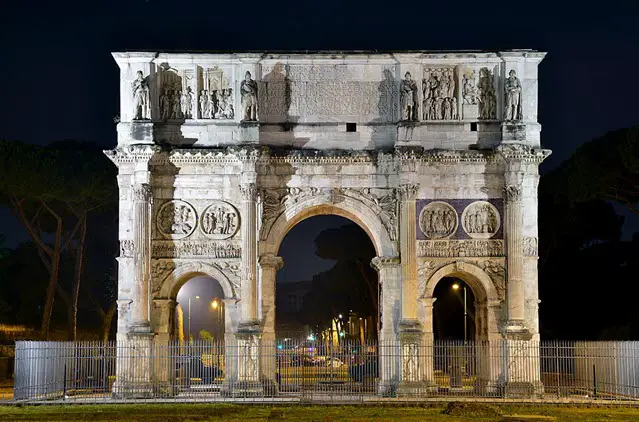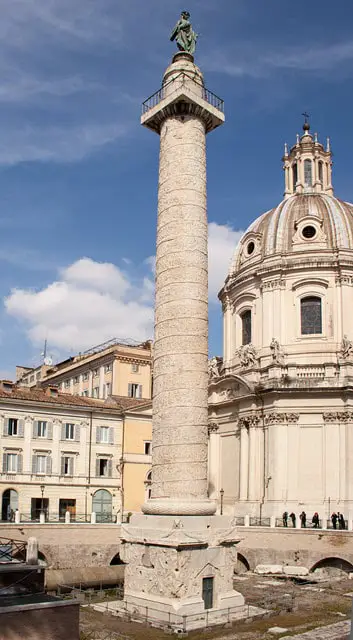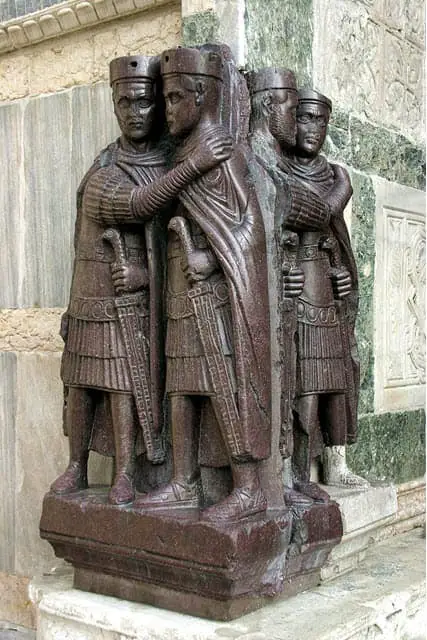Roman Empire, has always been known for its inventions, technologies, legends, mythologies, art, and sculptures.
Like all other innovations and inventions, the artwork created in this Empire during its era has a great value and impact on the world then and now.
The art includes both traditional and modern innovations and has the essence of conventional artwork practiced in ancient regions of Africa, Europe, and Asia.
However, not all the artwork and sculptures created in ancient Rome manage to survive forever. Most of them were destroyed within few years of their creation. Only a few could survive through those long years until today.
Three significant creations that survive until today include the Arch of Constantine, the Arch of Titus, and the Arch of Septimius Severus. These are the arches that were constructed during the Roman Era with complete dedication and perfection.
The other significant artwork and sculptures that were created in the Roman Era are discussed in this article.
10. Arch of Constantine
Content

Source: Wikimedia Common
Ancient Rome had a tradition of constructing a triumphal monument after the victory of any of the Emperors. The Arch of Constantine was one of them, and it was built to honor the Roman Emperor Constantine the Great’s victory over Maxentius in 312 AD at the battle of Milvian.
It is situated between Colosseum and Palatine Hill and took almost three years to be completed. The construction began in 312 AD and was completed in 315 AD.
Constantine was a prominent member of the Roman court who later became the Western Emperor in 1312 and the Roman Emperor in 324. He was famous as he had fought against the Persians under Diocletian in 297 and Galerius in 298.
The arch was built huge with dimensions of 69 feet in height and 85 feet in width as per the wish of Constantine. He wanted the monument to be one of the most significant monuments constructed in the Roman Era. The three parts of the arch made it unique and eye-catching for everyone.
The whole monument was built using concrete riveted in marble and had three arches, smaller two on both sides and a big one in the middle. The bottom portion consists of depicting the battle and many arts telling various stories of that period.
Though most other arches and monuments have disappeared, the Arch of Constantine, along with two other arches – the Arch of Titus and the Arch of Septimius Severus remain until today and are on the list of the largest surviving triumphal arch.
9. Trajan’s Column

Source: Wikimedia Common
Emperor Trajan’s victory over the Dacian in the two-year-long Dacian war was one of the most awaited victories in the Roman Era. The triumphal victory column constructed after this victory also became the most famous column in history.
The column, located in Trajan’s Forum on the north of the Roman Forum, was constructed under the supervision of Apollodorus of Damascus in between the years 106 and 113 CE.
As one of the most famous monuments, more than 2662 figures were crafted beautifully with almost 155 different scenes. Nearly all the scenes depict stories on their own, from marching of the Roman legion to Trajan’s speeches and military stunts.
The total dimension of this column is 98 feet in height with an extra 17 feet of a large pedestal consisting of 185 steps with a spiral shape. The viewing platform is at the top of the column, and the statue of Trajan is placed on the topmost portion of the column.
The design, architectural, and engineering skills used to construct this column inspired numerous other victory columns as they were built in the same format afterward. The most commonly known column-inspired from this includes Marcus Aurelius’s column and the Column of Antoninus Pius.
8. Column of Marcus Aurelius

Source: Wikimedia Common
As mentioned above, the model and design of this column were inspired by the column of Trajan. It is a victory column honoring Emperor Aurelius’s victory against the German and Sarmatian tribes. It is located in Piazza Colonna, Rome, Italy, near Emperor Marcus’s cremation.
The total height of this column is 97 feet with about 33 feet base, the full height above the ground is about 130 ft, and the remaining 9.8 feet is below the ground. It consists of 200 steps within the column and has the viewing platform on top and the statue of the Emperor at the topmost.
Numerous depictions and images are crafted on the outer wall depicting stories in each scene. The most famous one is the story of Marcus’s Danubian and Marcomannic wars that represent all the steps during the war, including a scene of the army crossing the Danube river to the victory.
Unfortunately, the original scripts and inscriptions have been destroyed from the column by the 16th Century, so the exact date of the construction is under controversy. However, as per one of the depictions from the original script, the structure was completed by 193 AD.
The restoration of the destroyed column was done in 1589 CE by Pope Sixtus the fifth, which changed the statue of Emperor Marcus to the statue of apostle St. Paul.
The original one was destroyed by the 16th Century and was restored in 1589 CE by Pope Sixtus the fifth with the change in the statue of Emperor Marcus to the statue of apostle St. Paul.
7. The Ara Pacis Augustae – The Altar of Augustan Peace

Source: Wikimedia Common
The Ara of Pacis Augustae, also known as Ara Pacis, meaning the Altar of Augustan Peace, is another significant art craft of the Romans. The Altar was situated in the northeastern corner of the Campus Martius in Rome.
The altar was built around 13 BC to honor the return of Augustus to Rome from Hispania and Gaul after about three years of successful campaigning and dedication to Pax – the Roman goddess of Peace.
Unfortunately, the altar was buried in flood around the Tiber River, Rome. Some portion of the remains were reassembled in 1938, leading to a change in the shape and its original orientation.
The positioning of the altar was also changed during the reassembling process. Initially, it was facing towards the western side and was later altered towards the north in 1938.
The original monument was built so that the center portion consisted of a traditional open-air altar surrounded by precinct walls built with Luna marble. The beautiful carvings of various images made within the altar depicted the law governing rituals performed.
The art and carvings used were one of the most refined forms of art of the Roman era made by using bucrania, an ox-skull. Another reason for its fame was its two-way entrances on the East and the West directions.
However, the most fantastic portion of this monument was the exterior precinct walls built in a rectangular shape with about 35 feet.
6. Fresco Wall from the House of Livia

Source: Wikimedia Common
The house of Livia, located on the Palatine Hill in Rome, was amongst one of the dowries brought by Livia when she married Emperor Augustus. The whole place itself was a piece of art of the Roman era; however, the most significant portion of this house was the Fresco wall from the House of Livia.
The Fresco Wall from this particular house dates back around the 1st Century BCE between 500 BCE and 1 CE. It had a total dimension of about 19 feet and was located in Muso Nazionale Romano, Rome, Italy.
As seen in almost every structure built in the Roman Era, the inner portion of this house was filled with beautiful drawings, images, and decorations. The pictures would primarily reflect nature by including various birds, flowers, plants, and trees.
These drawings were so clear that the individual species could easily be identified despite being made over 2000 years ago. The particular type of artwork, fresco, still stands as one of the most creative and magnificent artworks in history for its detailed work.
Many of the modern artists are also inspired by the art depicted on the wall. The skills and drawing made in the modern-day were somehow inspired by the Roman art style, detailing, and pure attention given to work.
5. Roman Mosaics

Source: Wikimedia Common
Mosaics were the particular drawing, images, or depictions made on tile, stone, or glass. They were mainly depicted on the wall or the floor and were invented during Roman Era.
The concept of these mosaics was established as the Romans had a culture of depicting almost all their daily acts and practicalities as a history to be told to their future generations.
Almost every house in the Roman era had specific art on its walls, floor, and ceilings. The Roman mosaics were, however, inspired by the Greek mosaics. Starting from a simple drawing of a plant and leading to the complex artwork of famous figures of Roman history and mythology, the Roman mosaic was known to everyone in the world.
One of the most famous mosaics was the Alexander Mosaic with the famous Alexander the Great image. It was made up of about 1.5 million small, cubed pieces of stones or glass cut out into various shapes, known as tesserae.
The initial purpose of making mosaic was to make the house, buildings, and structures look beautiful, which also helped keep the house cool. The paintings and arts were done in single stone or a tile and then combined to make a story that depicted the daily lifestyle of the Romans.
4. Ixion Room, House of Vetti

Source: Wikimedia Common
The House of Vetti is known for the beautiful frescoes of the Roman era. It has different rooms with numerous depictions of nature, day-to-day practicalities, and famous people and legends figures.
As one of the most desired houses of the Roman era located in Pompeii, the artwork included in this house has been an inspiration even to modern-day artists and enthusiasts. However, out of all the rooms in the House of Vetti, the Ixion Room takes the top due to the unique art pieces and frescoes on the tiles placed on the floors and walls.
This room mainly depicts the artwork related to the suffering of Ixion, who was tricked and punished by the cruel Hera. The most famous scene was when Hermes announced to chain Ixion to a fiery whee.
Ixion is tied to the wheel while Hephaestus holds the wheel with his hand to rotate. This mythological art is depicted on the eastern wall of the north triclinium, where Hera is shown sitting on the throne enjoying the whole process.
3. Portrait of the Four Tetrarchs

Source: Wikimedia Common
Another world-renowned sculpture constructed during the Roman era is the portrait of the Four Tetrarchs. It was located in the Piazza San Marco, which dates back around 300 AD, and shows the sculptures of four Roman Emperors standing close to each other.
The structures were made using porphyry – a purple-red colored stone with a great value during the Roman Era. The design was based on the Tetrarchy formed by Emperor Diocletian, especially to end civil wars and foreign invasion.
Emperor Diocletian thought of dividing the entire Roman Empire into two portions – Western and Eastern, and assigning different rulers. The need for division arose with the expansion of the territory of Rome, as one ruler could not rule the entire empire alone.
Each part would be ruled by one Augustus – senior emperor and one Caesar – junior emperor. The four statues were initially made in two pairs of Augusti and Caesars; however, all the four statues looked the same.
2. Dionysus frieze, Villa of mysteries

Source: Wikimedia Common
As House of Livia and House of Vetti, Villa of Mysteries is also known for the particular room whose wall is decorated with inspiring and creative portraits. The room is the Dionysus frieze, made around 50 BC, located at the front right of the villa in Pompeii, Italy.
The principal portrait in this room depicts a girl in her adulthood taking part in a marriage ceremony. Other images show numerous rituals that a girl needs to follow to enter and achieve womanhood and various stages in a person’s life that need to be cleared or achieved.
Dionysus frieze was a dining room where nobles, higher-level Romans, and celebrated personalities came to dine in. It was changed to a particular room with this fantastic frieze in about 50 BC.
The initial depiction was a woman’s initiation into the Dionysian Mysteries with a mysterious cult devoted to Bacchus, a Roman god. This room got its name from the famous portrait depicting a Greek God of wine, Dionysus.
Since then, this room has had thousands of visitors coming to witness the creative and beautiful artwork. It has inspired modern-day artists and creative minds as well with its detailed work and beauty.
The villa was disrupted due to the eruption in 79 AD, but luckily only minor damage was done to it.
1. Arch of Septimius Severus

Source: Wikimedia Common
The Arch of Septimius Severus built-in 203 is one of the three surviving arches constructed in the Roman Empire situated in the Roman Forum.
Like all other arches, this too was constructed to honor the victory of the Roman Emperor. The military conquests under Emperor Septimius led to the Roman empire’s expansion to Iran and present-day Iraq, which was an excellent achievement for the Romans. The arch was the result of this prestigious achievement.
Apart from the military conquest, it also represents the Parthian victories of Septimius along with his two sons Geta and Caracalla – in 194/195 and 197/199. The total dimension of this arch is 69 feet in height and 75 feet in width.
It is a white marble triumph, and the inner part has used travertine marble mixed with Procennesian marble. This is one of the most significant sculptures constructed during the Roman era consisting of two sets of reliefs, one with four large panels on each face and the other with eight panels.
Conclusion
Roman Empire, its Era, its Emperors, and the Roman inventions that came under the Roman Empire have always inspired and influenced the world of its time and the future.
The artwork and sculpture mentioned above are some of the world’s most inspirational pieces in history. Though most of them are not surviving in today’s world, their legends and some history attached to them have always impacted modern-day artists and enthusiasts.
